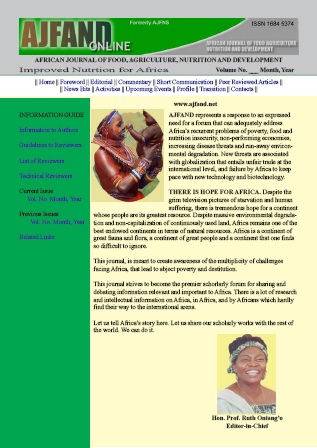
|
African Journal of Food, Agriculture, Nutrition and Development
Rural Outreach Program
ISSN: 1684-5358
EISSN: 1684-5358
Vol. 8, No. 3, 2008, pp. 252-264
|
 Bioline Code: nd08024
Bioline Code: nd08024
Full paper language: English
Document type: Research Article
Document available free of charge
|
|
|
African Journal of Food, Agriculture, Nutrition and Development, Vol. 8, No. 3, 2008, pp. 252-264
| en |
The Burden Of Malaria And Malnutrition Among Children Less Than 14 Years Of Age In A Rural Village Of Cameroon
Nkuo-Akenji, Theresa K.; Sumbele, I.; Mankah, E.N; Njunda, A.L.; Samje, M. & Kamga, L.
Abstract
Malaria and malnutrition are a major health burden in developing countries with infants and children being the most vulnerable groups. The extent of the burden of malaria and malnutrition was investigated in 339 children ≤14years residing in the village of Muea located in the South West Province of Cameroon. Malaria parasitaemia was determined microscopically from Giemsa stained thick blood films. Nutritional status was determined using age and the anthropometric parameters of weight and height. Height-for-age (HAZ), weight-for-age (WAZ) and weight-forheight (WHZ) Z scores were computed based on the National Centre for Health Statistics (NCHS)/World Health Organisation growth reference curves. Anaemia was assessed by measuring haemoglobin (Hb) concentration while plasma iron levels were determined by spectrophotometric assays. The prevalence of malaria in the study population was 96.2% (326/339) with a majority (68.4%) having asymptomatic disease. The geometric mean parasite density (GMPD) was 744.37 ± 89396.11 (parasitaemia range 40-153190 parasites/µL blood). The mean Hb concentration was 9.29 ± 1.8g/dL (range 4-14.1g/dL) and anaemia (Hb<11g/dL) was diagnosed in 81.4% of the children, a majority of whom had microcytic anaemia. A negative correlation was observed between parasite density and haemoglobin concentration (r = -0.14). The mean plasma iron level was 53.64 ± 32.87µL/dl (range 1.8-159) with 58.7% (199/339) of the children diagnosed as iron deficient (plasma iron concentrations <50µg/dL). A negative correlation was observed between plasma iron values and malaria parasitaemia (r = -0.031). The prevalence of malnutrition was 58.1% (197/339). Of the 197 malnourished children, 23.6% were wasted (< -2 SD weight-for-height Z- score), 26.5% underweight (< - 2 SD weight-for-age Z score) and 49.9% stunted (< - 2 SD height-for-age Z score). There was a negative correlation between nutritional status and malaria parasitaemia (r =-0.034). The findings from this study are strongly suggestive that falciparum malaria and malnutrition exist in children residing in Muea and constitute a major health problem which needs to be immediately addressed to reduce morbidity and mortality.
Keywords
Malaria, Malnutrition, Anaemia, Iron, Children.
|
| |
© Copyright 2008 -Rural Outreach Program
Alternative site location: http://www.ajfand.net/
|
|
